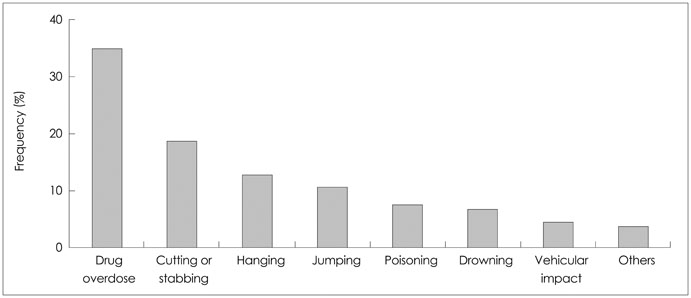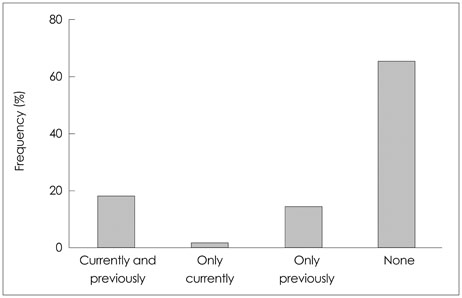J Clin Neurol.
2015 Jan;11(1):32-41. 10.3988/jcn.2015.11.1.32.
Suicidality and Its Risk Factors in Korean People with Epilepsy: A MEPSY Study
- Affiliations
-
- 1Department of Neurology, School of Medicine, Kyungpook National University, Daegu, Korea. sppark@mail.knu.ac.kr
- 2Department of Neurology, Daegu Fatima Hospital, Daegu, Korea.
- 3Department of Neurology, Dongsan Medical Center, Keimyung University School of Medicine, Daegu, Korea.
- 4Department of Neurology, Yeungnam University College of Medicine, Daegu, Korea.
- 5Department of Neurology, Catholic University of Daegu School of Medicine, Daegu, Korea.
- KMID: 2179570
- DOI: http://doi.org/10.3988/jcn.2015.11.1.32
Abstract
- BACKGROUND AND PURPOSE
People with epilepsy (PWE) are more likely to experience suicidality, with suicidal ideation and attempts, than people without epilepsy (PWoE). The aims of the present study were to determine 1) the characteristics of suicidality in Korean PWE, 2) whether PWE with suicidality receive psychiatric intervention, and 3) the risk factors for suicidality.
METHODS
Patients who consecutively visited epilepsy clinics at secondary- and tertiary-care hospitals were recruited (n=684), along with age- and sex-matched PWoE (n=229). The presence of current major depressive disorder (MDD), generalized anxiety disorder (GAD), and/or suicidality was established using the Mini International Neuropsychiatric Interview-Plus Version 5.0.0. The Korean version of the Liverpool Adverse Events Profile (K-LAEP) was applied to detect adverse effects of antiepileptic drugs (AEDs).
RESULTS
Suicidality was present in 208 (30.4%) of the 684 PWE. The rate of suicidality was 4.6 times higher among PWE than PWoE, and 108 (15.7%) PWE had suicidal ideation and had attempted suicide. Among those who had attempted suicide, 40.7% had made at least two attempts. The most common method of suicide attempt was drug overdose (34.9%). Unfortunately, of the 208 PWE with suicidality, 136 (65.4%) did not receive psychiatric intervention. The risk factors for suicidality were MDD [odds ratio (OR)=6.448, 95% confidence interval (CI)=3.739-11.120, p<0.001], GAD (OR=3.561, 95% CI=1.966-6.452, p<0.001), item scores of 3 or 4 on the K-LAEP (OR=2.688, 95% CI=1.647-4.387, p<0.001), and a history of febrile convulsion (OR= 2.188, 95% CI=1.318-3.632, p=0.002).
CONCLUSIONS
Suicidality is more prevalent in PWE than in PWoE. Clinicians should monitor psychiatric disorders and the adverse effects of AEDs in PWE in an attempt to reduce the incidence of suicidal ideation or suicide attempts in this patient population.
Keyword
MeSH Terms
Figure
Reference
-
1. Hawton K, van Heeringen K. Suicide. Lancet. 2009; 373:1372–1381.
Article2. Värnik P. Suicide in the world. Int J Environ Res Public Health. 2012; 9:760–771.
Article3. Organisation for Economic Co-operation and Development (OECD). Health at a Glance 2013: OECD indicators [Internet]. [place unknown]: OECD Publishing;2013. cited 2013 Nov 21. Available from: http://dx.doi.org/10.1787/health_glance-2013-en.4. Jeon HJ. Depression and suicide. J Korean Med Assoc. 2011; 54:370–375.
Article5. Kwon OY, Park SP. Depression and anxiety in people with epilepsy. J Clin Neurol. 2014; 10:175–188.
Article6. Kwon OY, Park SP. Frequency of affective symptoms and their psychosocial impact in Korean people with epilepsy: a survey at two tertiary care hospitals. Epilepsy Behav. 2013; 26:51–56.
Article7. Tellez-Zenteno JF, Patten SB, Jetté N, Williams J, Wiebe S. Psychiatric comorbidity in epilepsy: a population-based analysis. Epilepsia. 2007; 48:2336–2344.
Article8. Christensen J, Vestergaard M, Mortensen PB, Sidenius P, Agerbo E. Epilepsy and risk of suicide: a population-based case-control study. Lancet Neurol. 2007; 6:693–698.
Article9. Mościcki EK. Epidemiologic surveys as tools for studying suicidal behavior: a review. Suicide Life Threat Behav. 1989; 19:131–146.10. Jones JE, Hermann BP, Barry JJ, Gilliam FG, Kanner AM, Meador KJ. Rates and risk factors for suicide, suicidal ideation, and suicide attempts in chronic epilepsy. Epilepsy Behav. 2003; 4:Suppl 3. S31–S38.
Article11. Nilsson L, Ahlbom A, Farahmand BY, Asberg M, Tomson T. Risk factors for suicide in epilepsy: a case control study. Epilepsia. 2002; 43:644–651.
Article12. Kalinin VV, Polyanskiy DA. Gender differences in risk factors of suicidal behavior in epilepsy. Epilepsy Behav. 2005; 6:424–429.
Article13. Brent DA, Crumrine PK, Varma RR, Allan M, Allman C. Phenobarbital treatment and major depressive disorder in children with epilepsy. Pediatrics. 1987; 80:909–917.14. Levenson M, Rochester CG, Mentari E, Hughes A, Feeney J 3rd, Stone M, et al. Statistical review and evaluation: antiepileptic drugs and suicidality [Internet]. Silver Spring (MD): U.S. Food and Drug Administration;2008. cited 2014 May 23. Available from: http://www.fda.gov/Drugs/DrugSafety/PostmarketDrugSafetyInformationforPatientsandProviders/ucm100190.htm.15. Mula M, Sander JW. Suicide risk in people with epilepsy taking antiepileptic drugs. Bipolar Disord. 2013; 15:622–627.
Article16. Lim HW, Song HS, Hwang YH, Lee HW, Suh CK, Park SP, et al. Predictors of suicidal ideation in people with epilepsy living in Korea. J Clin Neurol. 2010; 6:81–88.
Article17. Verrotti A, Cicconetti A, Scorrano B, De Berardis D, Cotellessa C, Chiarelli F, et al. Epilepsy and suicide: pathogenesis, risk factors, and prevention. Neuropsychiatr Dis Treat. 2008; 4:365–370.
Article18. Proposal for revised clinical and electroencephalographic classification of epileptic seizures. From the Commission on Classification and Terminology of the International League Against Epilepsy. Epilepsia. 1981; 22:489–501.19. Proposal for classification of epilepsies and epileptic syndromes. Commission on Classification and Terminology of the International League Against Epilepsy. Epilepsia. 1985; 26:268–278.20. Berg AT, Shinnar S, Levy SR, Testa FM, Smith-Rapaport S, Beckerman B. Early development of intractable epilepsy in children: a prospective study. Neurology. 2001; 56:1445–1452.
Article21. Deckers CL, Hekster YA, Keyser A, Meinardi H, Renier WO. Reappraisal of polytherapy in epilepsy: a critical review of drug load and adverse effects. Epilepsia. 1997; 38:570–575.
Article22. World Health Organization Collaborating Centre for Drug Statistics Methodology (NO). ATC/DDD Index 2014 [Internet]. Oslo: World Health Organization Collaborating Centre for Drug Statistics Methodology;2013. cited 2013 Nov 1. Available from: http://www.whocc.no/atc_ddd_index/.23. Yoo SW, Kim YS, Noh JS, Oh KS, Kim CH, Namkoong K, et al. Validity of Korean version of the Mini-International Neuropsychiatric Interview. Anxiety Mood. 2006; 2:50–55.24. Park JM, Seo JG, Park SP. Validity and reliability of the Korean version of the Liverpool Adverse Events Profile (K-LAEP) in people with epilepsy. J Korean Epilepsy Soc. 2012; 16:43–48.25. Sheehan DV, Lecrubier Y, Sheehan KH, Amorim P, Janavs J, Weiller E, et al. The Mini-International Neuropsychiatric Interview (M.I.N.I.): the development and validation of a structured diagnostic psychiatric interview for DSM-IV and ICD-10. J Clin Psychiatry. 1998; 59:Suppl 20. 22–33. quiz 34-57.26. Baker GA, Jacoby A, Buck D, Stalgis C, Monnet D. Quality of life of people with epilepsy: a European study. Epilepsia. 1997; 38:353–362.
Article27. Meyer N, Voysey M, Holmes J, Casey D, Hawton K. Self-harm in people with epilepsy: a retrospective cohort study. Epilepsia. 2014; 55:1355–1365.
Article28. Morovatdar N, Moradi-Lakeh M, Malakouti SK, Nojomi M. Most common methods of suicide in Eastern Mediterranean Region of WHO: a systematic review and meta-analysis. Arch Suicide Res. 2013; 17:335–344.
Article29. Ung EK. Youth suicide and parasuicide in Singapore. Ann Acad Med Singapore. 2003; 32:12–18.30. Bose A, Konradsen F, John J, Suganthy P, Muliyil J, Abraham S. Mortality rate and years of life lost from unintentional injury and suicide in South India. Trop Med Int Health. 2006; 11:1553–1556.
Article31. Shin SD, Suh GJ, Rhee JE, Sung J, Kim J. Epidemiologic characteristics of death by poisoning in 1991-2001 in Korea. J Korean Med Sci. 2004; 19:186–194.
Article32. Ministry of Health and Welfare (KR). Brief report of national survey on suicide 2013. Available from: http://download.mw.go.kr/front_new/modules/download.jsp?BOARD_ID=140&CONT_SEQ=299571&FILE_SEQ=148548.33. Kanner AM, Kozak AM, Frey M. The Use of Sertraline in Patients with Epilepsy: Is It Safe? Epilepsy Behav. 2000; 1:100–105.
Article34. Jones JE, Hermann BP, Barry JJ, Gilliam F, Kanner AM, Meador KJ. Clinical assessment of Axis I psychiatric morbidity in chronic epilepsy: a multicenter investigation. J Neuropsychiatry Clin Neurosci. 2005; 17:172–179.
Article35. Wiegartz P, Seidenberg M, Woodard A, Gidal B, Hermann B. Co-morbid psychiatric disorder in chronic epilepsy: recognition and etiology of depression. Neurology. 1999; 53:5 Suppl 2. S3–S8.36. Shneker BF, Cios JS, Elliott JO. Suicidality, depression screening, and antiepileptic drugs: reaction to the FDA alert. Neurology. 2009; 72:987–991.
Article37. Gilliam FG, Barry JJ, Hermann BP, Meador KJ, Vahle V, Kanner AM. Rapid detection of major depression in epilepsy: a multicentre study. Lancet Neurol. 2006; 5:399–405.
Article38. Ko PW, Hwang J, Lim HW, Park SP. Reliability and validity of the Korean version of the Neurological Disorders Depression Inventory for Epilepsy (K-NDDI-E). Epilepsy Behav. 2012; 25:539–542.
Article39. Seo JG, Cho YW, Lee SJ, Lee JJ, Kim JE, Moon HJ, et al. Validation of the generalized anxiety disorder-7 in people with epilepsy: a MEPSY study. Epilepsy Behav. 2014; 35:59–63.
Article40. Kanner AM, Barry JJ, Gilliam F, Hermann B, Meador KJ. Depressive and anxiety disorders in epilepsy: do they differ in their potential to worsen common antiepileptic drug-related adverse events? Epilepsia. 2012; 53:1104–1108.
Article41. Finegersh A, Avedissian C, Shamim S, Dustin I, Thompson PM, Theodore WH. Bilateral hippocampal atrophy in temporal lobe epilepsy: effect of depressive symptoms and febrile seizures. Epilepsia. 2011; 52:689–697.
Article42. López JF, Chalmers DT, Little KY, Watson SJ. A.E. Bennett Research Award. Regulation of serotonin1A, glucocorticoid, and mineralocorticoid receptor in rat and human hippocampus: implications for the neurobiology of depression. Biol Psychiatry. 1998; 43:547–573.
Article
- Full Text Links
- Actions
-
Cited
- CITED
-
- Close
- Share
- Similar articles
-
- The Relationship Between Anger and Suicidality
- Risk and Protection Factors for Suicidality in Korean Military Officers
- Effect of Long-Term Treatment with Vagus Nerve Stimulation on Mood and Quality of Life in Korean Patients with Drug-Resistant Epilepsy
- The Link between Suicidality and Electroencephalography Asymmetry: A Systematic Review and Meta-analysis
- Epilepsy and Mortality



